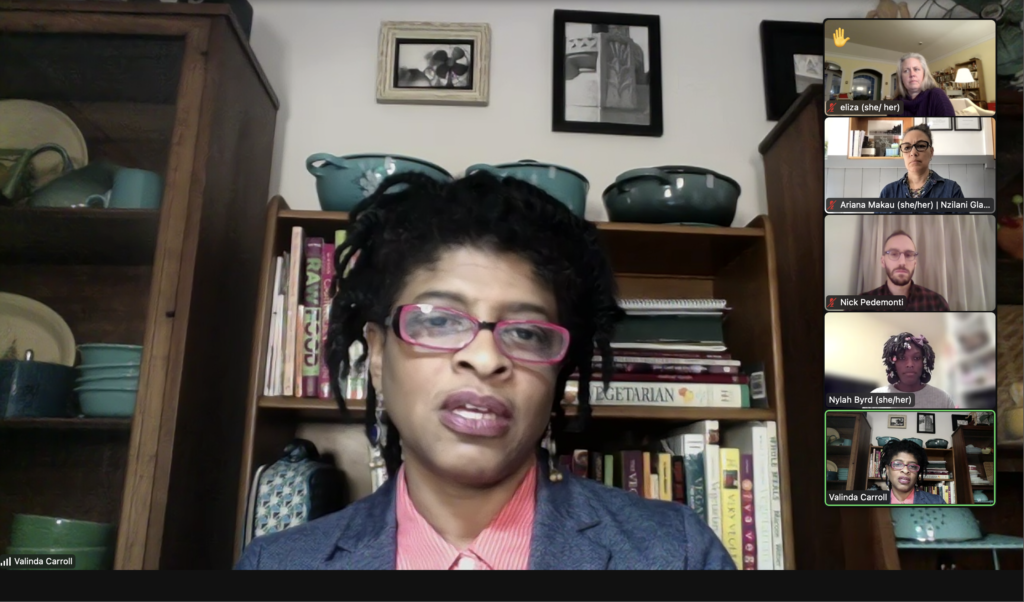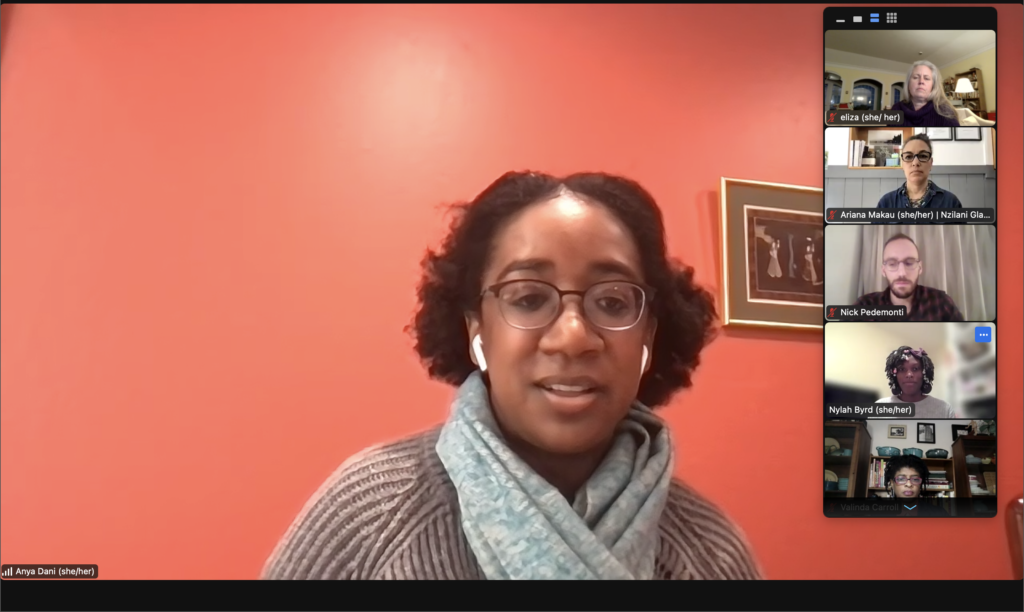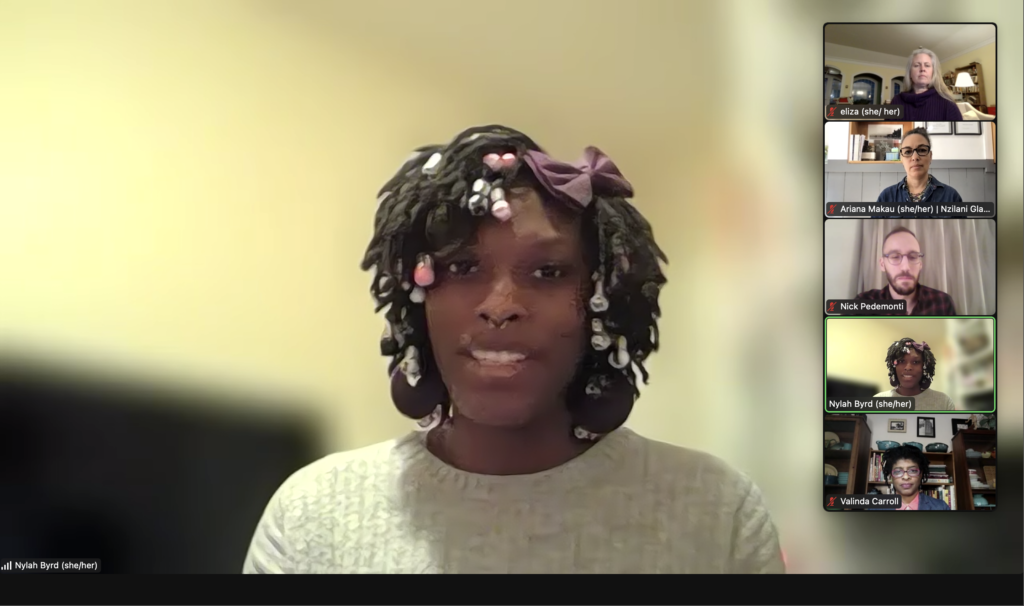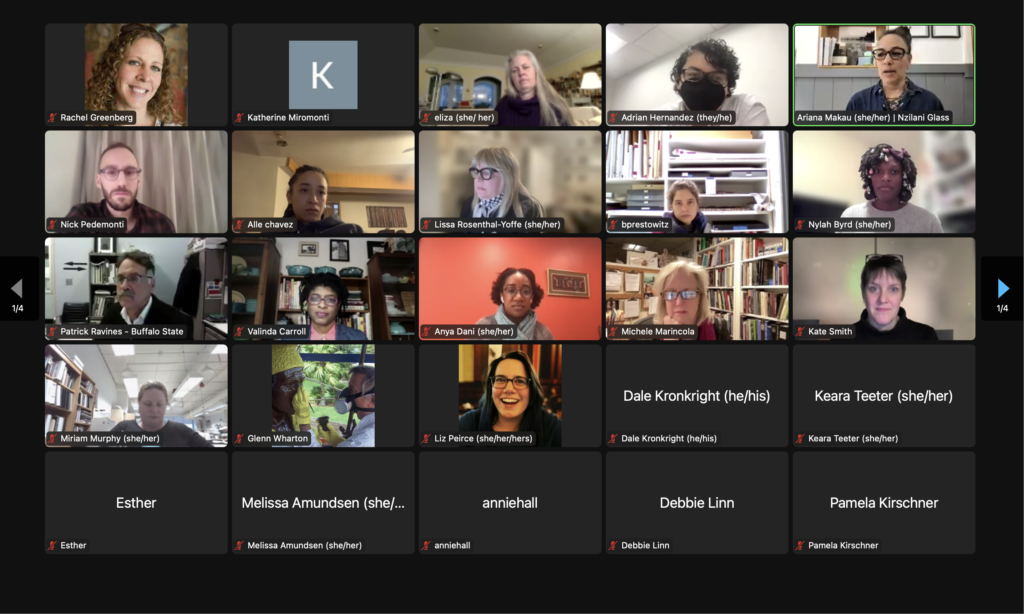Speakers: Valinda Carroll, Anya Dani, Nylah Byrd, and Ariana Makau
Summarized by Katherine Miromonti
This February, four conservators––Valinda Carroll, Anya Dani, Nylah Byrd, and Ariana Makau––led a panel about the Black Art Conservators group (BAC) and their experiences as Black conservators in the cultural heritage field. The Black Art Conservators group was founded in 2020 and now has members from all over the world including South Africa, Canada, Norway, and the United States. Membership comprises individuals with a wide variety of experience from pre-program students to seasoned professionals with decades of experience. These students and conservators have come together for a variety of different reasons, including the desire for community, and creating a space to be heard when advocating for equity in the conservation field. The panelists covered a variety of topics including BAC’s 2020 statement in support of #BlackLivesMatter and racial justice in the conservation field, the importance of community, pipeline programs, and the present and future of DEAI (diversity, equity, access, and inclusion) work in the field.




BAC’s statement contains a detailed list of specific actions that individuals and institutions can take to stand in solidarity with Black conservators and create more equity and opportunities for Black, Indigenous, and People of Color (BIPOC) in the cultural heritage field. These actions include, but are not limited to, addressing the lack of diversity in leadership roles, investing time and money in the preservation of BIPOC material culture, and ensuring equitable pay for BIPOC employees. The panelists reported that feedback on the statement has been positive and that many people found it to be eye-opening.
The conservators on the panel also discussed their individual experiences as part of BAC over the past three years. Byrd described how the organization was founded organically, without strict expectations. It is first and foremost an organization designed to provide the opportunity for Black conservators to connect with other Black conservators. Dani agreed that the sense of community created by the Black Art Conservators group exceeded her expectations. She described how many Black conservators have not had the opportunity to work together, due to being extremely underrepresented in the field; however, BAC allows Black conservators across the country and world to grow and maintain relationships with one another. Carroll added that the structure to communicate regularly provided by BAC––meeting informally online every 4-6 weeks––is a wonderful benefit for everyone and that she hopes that the network of Black conservators will continue to grow. Makau shares the hope of the other panelists that BAC will continue to grow and provide community and opportunities to Black conservators. She described her own role in the group as a mentor, having over 25 years of conservation experience. BAC is a place where she can give back by giving advice and answering questions about navigating the field. The type of mentorship and support provided by BAC is especially important in the cultural heritage field where BIPOC conservators and museum professionals often navigate discrimination, racism, microaggressions, and triggering images and collections to which their white peers may be desensitized.
Each of the conservators on the panel is involved in outreach and advocacy in one way or another. They have not only provided recommendations and resources regarding diversity, equity, access, and inclusivity, they have been doing and continue to do the difficult, tangible work needed to improve the field. A few examples of this include, engaging the public and professionals in presentations or working directly with marginalized communities to preserve their material culture and community spaces. When describing their work, the panelists stressed the importance of compensation for labor especially when it comes to DEAI work.
The panelists pointed out that, in many fields, DEAI work is a full-time job; therefore, asking people to volunteer for such positions is unfair. They acknowledged that DEAI work is a crucial part of creating equity in the cultural heritage field, and finding funds for monetary compensation is not always possible. Dani discussed some possible short-term solutions to this issue, including compensating workers with free training or memberships and instating term limits on DEAI positions. Long term, however, people (especially BIPOC) performing DEAI work must be fairly compensated for their labor. Fair compensation positively benefits not only individuals, but benefits organizations overall as people paid equitably are more motivated to do thorough work and make meaningful change.
The second half of the meeting involved an in-depth discussion of access, inclusion, and pipeline programs. While all the panelists agreed that pipeline programs are beneficial to an extent, they are not enough.
Byrd spoke about her interest in material culture beginning in the sixth grade and how she wishes that young people had access to mentors earlier. She also talked about access and inclusion in higher education. For example, it is important to direct mentorship and internship opportunities toward BIPOC at both Historically Black Colleges and Universities (HBCUs) and predominantly white institutions (PWIs). Byrd has been doing work related to inclusivity and justice throughout her pre-program, educational, and professional careers and encourages individuals to examine their personal responsibility in making the conservation field more inclusive.
Makau also touched on the topic of introducing conservation to younger age groups. She gives talks about her profession at her children’s grade school, not only to introduce them to the profession, but to show them that people who look like them work this field. She described how representation of diverse groups of people doing diverse work is very important for children and young people.
Dani and Carroll built off these ideas, emphasizing that introducing conservation to young people is not the only solution to the lack of inclusivity in the cultural heritage field. Dani discussed the importance of creating safe and equitable work environments for BIPOC once they begin working in institutions. This includes providing fair wages for all employees, centering DEAI and anti-racism in all facets of the workplace, and instating consistent, effective, and mandatory DEAI training for all employees.
Carroll touched on another aspect of the issue with pipeline programs: the question of what happens after the program. Pipeline programs alone are not enough to help students break into the field, there must be mentoring and internships to follow these short programs. Carroll also stressed the importance of diversity in leadership positions, as this is not only beneficial for young professionals entering the field, but for institutions as a whole and the communities that they serve.
The Black Art Conservators’ group has provided several resources for learning about their organization and diving into DEAI work on their website: https://blackartconservators.com/. Please take a moment to read their statement “Join Black Conservators and Demand Racial Justice in Art Conservation” and visit their Resources page. If you are interested in learning more about equity and inclusion, also check out AIC’s Equity and Inclusion Committee.
Update (4/30/2023):
The February panel event was recently reviewed by WCG member LaStarsha McGarity for IIC News in Conservation.
“A Synopsis of the Black Art Conservators Panel Discussion at the Washington Conservation Guild.” IIC News in Conservation, Issue 95 (April–May 2023): 54–57.
Click here for the ISSUU version
Click here for the PDF version